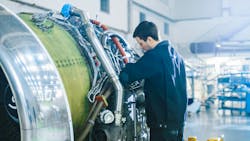If you’ve ever seen a Nascar or Formula 1 race, you’ll know that the unsung heroes are the pit crews. While the driver may get all the glory for winning the race and go down in the record books, ultimately they cannot win if the pit crew isn’t top-notch. Victory and defeat can be decided by the smallest of margins and times are measured down to the nearest millisecond. Drivers rely on their crews knowing their jobs, having the materials they need at the ready and ultimately executing the changes when the opportunity comes – the airline industry is no different.
With massive up-front costs to purchase aircraft, and earning relatively meager profits per passenger, airlines must keep their aircraft in the air to maximize ROI (Return On Investment). Any missed flight may cost airlines hundreds of thousands of dollars, and in extreme cases, as is the case with the grounded Boeing 737-Max fleets, can cost airlines tens or even hundreds of millions of dollars a year, which is projected to be the case for American Airlines and Southwest. While it’s true that the Boeing Max has been grounded due to a software issue, rather than a logistical one, it’s not hard to envision mass groundings due to logistical troubles.
In January, the FAA considered a recall on some 148 Boeing parts, that would have impacted roughly 300 active Boeing aircraft. The parts were suspected to be “susceptible to premature failure or cracks” and airlines were to be given 10 days to replace the parts should the recall be called into effect. While this time frame is no problem for a small scale racing pit crew, who have all the materials on hand, airline MRO (maintenance, repair and overhaul) departments would have a much harder time dealing with an issue. Unlike racing crews, airlines function on a global scale and parts sourced for a repair in one country may originate halfway across the world.
Despite an industry valuation of $80 billion, current MRO largely relies on antiquated systems. Out-of-date websites, inventories listed on excel sheets that may or may not have been updated in the past few months and manual searching are all hallmarks of the current procurement process. Every time MRO teams require a part, they must comb through individual supplier sites and manually send each RFQ. The process is time-consuming and extremely inefficient in an industry where every hour counts against the bottom line.
With airlines on pace for their worst year since 2014, many are looking for a way to improve margins wherever they can. Conventional wisdom might be to pass the expenses over to consumers by raising ticket prices to recoup some of the losses. However, there are only so many passengers who are willing to pay high prices for a flight and the fierce competition among airlines (and now budget airlines) ensures that prices largely cannot exceed a certain benchmark. So, if the airlines cannot recoup the fees on the front end, they must look internally to see what costs they can cut and what solutions they can provide to trim the fat on their back-end budgets.
Investing in MRO can be the panacea that airlines are looking to save their falling bottom lines. The biggest issue MRO faces is time. Unlike pit crews, airline MRO teams cannot possibly have every single part on hand in every location as the cost of owning and storing that volume of inventory properly would be astronomical. Instead, they must often take it on a case-by-case basis and are left waiting until the part can be procured. Between manually searching, sending RFQs, waiting on replies, and actually acquiring and installing the needed part, the process is convoluted and unnecessarily long, costing airlines thousands and potentially millions as a result of flights lost to AOG (Aircraft On Ground).
While airlines focus heavily on upgrading consumer-facing technologies to attract customers, the logistics side is primed for an important overhaul that can change the margins for any airline. Adopting new technologies such as predictive analytics can help MRO teams to determine where and when parts will most likely be needed, dramatically cutting down on the time until aircraft can undergo maintenance. New artificial intelligence-based platforms and marketplaces that help locate and procure parts can improve the visibility of the parts market to lower prices and drastically cut down on the costs associated with AOG. These technologies are already starting to penetrate the market and will prove a huge boom to airlines with enough foresight to be early adopters, as the reduction in these costs represents pure savings and will instantly help the bottom line.
Ultimately, MRO departments work around the clock to ensure that aircraft remain active and flights leave as scheduled, but, at current, they are not equipped with the right tools. You could never expect a pit crew to function without having the correct parts on hand and the right tools to make the adjustments mid-race, and the same goes for airline MROs. Airlines must invest in the behind-the-scenes logistics as much as they are investing in passenger-facing features to ensure the profitability of the endeavor. While it would be nice for passengers to enjoy WiFi on international flights, better infotainment systems, or even added meal service, the added perks don’t amount to much if the aircraft is stuck on the ground while the MRO team scrambles to source some obscure part.
